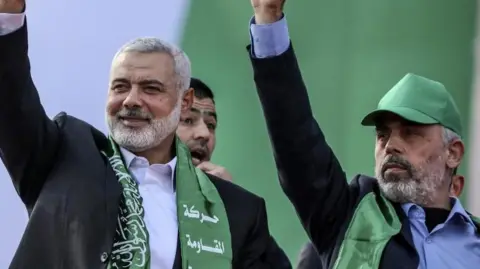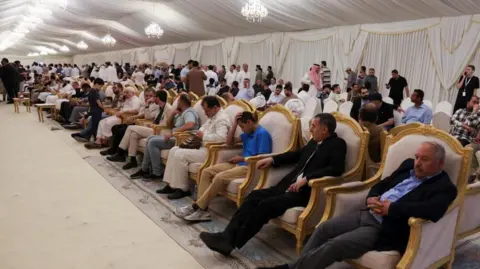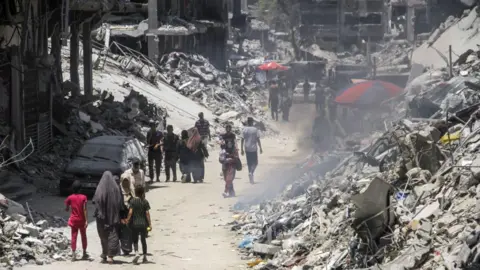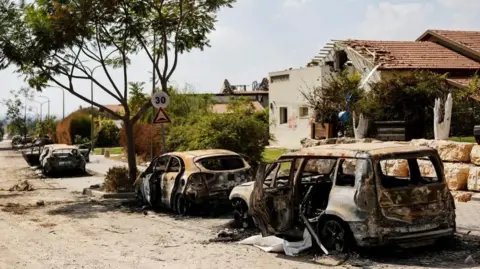Behind the scenes as Hamas elects its new leader

 EPA
EPALast week, with the world media watching, top Hamas leaders flocked to Qatar to elect a new political leader for their party.
Attendees are pouring in from across the Middle East after the nearly year-long war between Hamas and Israel in Gaza.
Others were shocked, as a few days ago they heard the news that the former political leader of this party – Ismail Haniyeh – was killed in an explosion in Tehran, allegedly by Israel.
Haniyeh, who oversaw his party’s negotiators in the talks with Israel, played a key role in Hamas, balancing the terror wing’s desire to take the war to Israel with calls from others to reach a solution and end the conflict.
His position, it was clear, needed to be filled immediately.
At a mourning ceremony in Doha, Hamas leaders applauded in a large white tent with carpets and plush chairs, decorated with pictures of Ismail Haniyeh. Hundreds of people gathered to pay their respects to the late leader of the organization and his bodyguards.
This event was more than a memorial service – it marked the end of an era and the beginning of a new, more extreme phase.
It was not the first time I have seen senior Hamas officials gather to elect a new leader after an unexpected funeral. Back in 2004 I saw them meet after Israel killed the group’s founder Sheikh Ahmed Yassin – a meeting at his house in Gaza. Less than a month later, Israel killed his successor, Abdel Aziz al-Rantisi.
But this time the discussions behind the stage showed the magnitude of the problem and challenges they are facing.
 Reuters
ReutersHamas attacked southern Israel on October 7 last year, killing around 1,200 people and taking 251 hostages back to Gaza. Since then, Israeli military retaliation has killed more than 39,600 people, according to the Hamas-run health ministry, and injured tens of thousands more. More than half of the buildings in Gaza were damaged or destroyed and almost all the people were left homeless. Tensions with Hamas, which has ruled Gaza since 2007, are growing. The group itself suffered a lot.
On top of this, the assassination of Ismail Haniyeh on 31 July in Tehran – a place he had always felt was a safe place – really shocked the movement.
Hamas is certain that Haniyeh was killed by an anti-personnel missile while he was browsing on his phone. Iran’s Revolutionary Guards said a projectile with a 7kg warhead was used. Some Western media reports say that he was killed by a bomb that had been placed in a room earlier.
Back at Haniyeh’s mourning ceremony in Doha, one man in his mid-60s with white hair and a short beard stood in a corner away from the light.
“Pay close attention to him,” the Hamas press officer told me. Who was he? “You are a shadowy man, Abu Omar Hassan,” he said.
Abu Omar Hassan, or Mohamed Hassan Darwish, is the head of the Supreme Shura Council, the highest consultative body in Hamas. According to the Hamas constitution, he was in the position of temporary head of the organization until the elections that were supposed to be held next March.
“He is a man of great missions,” I was told.
As the mourning ceremony ended, the real work of these leaders began. For two days, the organization’s veterans and dark figures held meetings in Doha, which has housed the political office of Hamas since 2012, to choose a new leader.
 Getty Images
Getty ImagesThey chose Yahya Sinwar, who has been the leader of the group inside Gaza since 2017. The selection may come as a surprise to many, but anyone who has followed his career since Israel released him in a 2011 exchange deal for captured Israeli soldier Gilad Shalit knew he was always a possibility. to lead Hamas one day.
No political leader in Hamas has approached the armed wing of the group. His brother Mohammed heads Hamas’s main military force, and Mohammed Deif – a little-known Hamas veteran who led its armed wing for two decades until Israel said he killed him last month – was his neighbor, friend and classmate. . The two grew up together in Gaza’s fledgling Khan Younis refugee camp.
Despite all this, many may see putting him in the most important position in Hamas as madness. Israeli security agencies believe that Sinwar planned and carried out the attack in southern Israel, and is at the top of their wanted list.
“Not everyone in the Hamas leadership was in favor of this decision,” a senior Hamas official told me. “Some leaders have raised their complaints, others are looking for a moderate person. But in the end he got more votes.”
Another Hamas official who attended the meetings said that the organization felt unable to choose the powerful figure Abu Omar Hassan because he had a small public profile and was unknown outside the organization, while the October 7 attack made Yahya Sinwar known around the world.
“Sinwar has become a trademark after October 7 and is very popular in the Arab and Muslim world,” said the official. “He enjoys close relations with the resistance axis supported by Iran, and his appointment in the middle of the war sends a message of contempt for Israel.”
The “axis of resistance” is a network of armed groups supported by Iran. Other members such as Lebanon-based Hezbollah also present threats to Israel.
 Reuters
ReutersMany Arab and other Western officials have urged Hamas not to name Sinwar as leader because of his links to the October 7 attacks. He and the organization he leads are now considered terrorists by many Western governments.
“One of the reasons why we voted for him is that we want to respect him for being a mastermind in the attack,” said the official. “The 7th of October is his, so he deserves to lead the movement.”
Ten months after the attack, all efforts to agree to a ceasefire have so far failed. The BBC understands that the two main negotiators – Qatar and Egypt – are working on a new ceasefire proposal.
Leaks suggest that the plan is based on convincing Iran not to respond militarily to the killing of Haniyeh on its territory, in order for Israel to end its war in Gaza and withdraw troops from the Philadelphia tunnel.
The Philadelphia Corridor is a buffer zone, only about 100m (330ft) wide in parts, that runs along Gaza’s 13km (8-mile) border with Egypt. Gaza’s only other border is with Israel itself.
A Palestinian official familiar with the ceasefire talks told me in Doha: “Egyptian intelligence has already sent a team to Doha and there are meetings to plan a plan based on regional security and a possible Iranian response … to end the shooting.”
In the meantime, the drumbeat of conflict is intensifying, as Sinwar, the most radical figure in Hamas, is set to lead the group for the next five years – if he survives the war.
Source link




